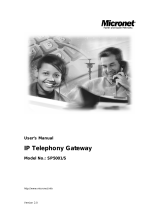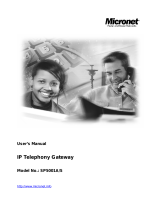Page is loading ...

Table of Contents
1. VOIP GATEWAY OVERVIEW..............................................................................................................4
1.1. OVERVIEW.....................................................................................................................................4
1.2. FEATURES .....................................................................................................................................4
1.3. DEFAULT SETTINGS ........................................................................................................................5
1.4. HARDWARE SPECIFICATIONS ..........................................................................................................6
2. GETTING STARTED............................................................................................................................9
2.1. SETTING UP THE GATEWAY .............................................................................................................9
2.2. CONFIGURE THE FXS GATEWAY IP ADDRESS .................................................................................13
2.3. CONFIGURE PROXY MODE............................................................................................................13
2.4. SAVING YOUR CONFIGURATIONS ....................................................................................................14
2.5. EXAMPLE DIAGRAM ......................................................................................................................14
3. WEB CONFIGURATION....................................................................................................................15
3.1. SETTING UP THE TCP/IP PROTOCOL ............................................................................................15
3.2. ACCESSING THE WEB CONFIGURATION .........................................................................................19
3.3. CONFIGURE IP ADDRESS ..............................................................................................................21
3.4. CONFIGURE PROXY MODE............................................................................................................23
3.5. SAVING YOUR CONFIGURATIONS ....................................................................................................24
3.6. IP SHARING CONFIGURATION........................................................................................................26
3.7. TWO GATEWAYS ATTACHED TO IP SHARING DEVICE(ROUTER).........................................................28
4. MAKING A VOIP CALL .....................................................................................................................30
4.1. PEER-TO-PEER MODE CONFIGURATION .........................................................................................30
5. UPGRADE ROM VERSION...............................................................................................................32
6. WEB INTERFACE COMMAND LIST.................................................................................................34
6.1. NETWORK INTERFACE ..................................................................................................................35
6.2. SIP INFORMATION ........................................................................................................................37
6.3. SYSTEM CONFIGURATION .............................................................................................................38
6.4. PPPOE CONFIGURATION..............................................................................................................39
6.5. VOICE CONFIGURATION ................................................................................................................40
6.6. PHONE PATTERN CONFIGURATION ................................................................................................41
6.7. SUPPORT CONFIGURATION ...........................................................................................................42
6.8. PHONE BOOK CONFIGURATION .....................................................................................................43
6.9. DSCP CONFIGURATION................................................................................................................44
6.10. PASSWORD CONFIGURATION ........................................................................................................45
1

6.11. ROM UPGRADE ...........................................................................................................................46
6.12. FLASH CLEAN ..............................................................................................................................47
6.13. COMMIT DATA ..............................................................................................................................47
6.14. REBOOT SYSTEM .........................................................................................................................47
7. COMMAND LIST................................................................................................................................48
7.1. [HELP] .........................................................................................................................................49
7.2. [QUIT] ..........................................................................................................................................49
7.3. [DEBUG].......................................................................................................................................50
7.4. [REBOOT].....................................................................................................................................51
7.5. [COMMIT] .....................................................................................................................................51
7.6. [IFADDR] ......................................................................................................................................52
7.7. [TIME] ..........................................................................................................................................55
7.8. [PING]..........................................................................................................................................55
7.9. [PBOOK].......................................................................................................................................55
7.10. [PPPOE] .......................................................................................................................................57
7.11. [FLASH]........................................................................................................................................58
7.12. [SYSCONF] ...................................................................................................................................59
7.13. [SIP] ............................................................................................................................................61
7.14. [SECURITY] ..................................................................................................................................62
7.15. [VOICE] ........................................................................................................................................63
7.16. [SUPPORT] ...................................................................................................................................65
7.17. [TOS] ...........................................................................................................................................66
7.18. [PHONE].......................................................................................................................................67
7.19. [BUREAU].....................................................................................................................................69
7.20. [ROM] ..........................................................................................................................................70
7.21. [PASSWD].....................................................................................................................................71
2

About this User’s Manual
This user’s guide gives hardware specifications and explains web configuration and
command line configuration for the FXS Gateway SP5001/S.
Online Upgrade
Please refer to http://www.micronet.info/ for additional support documentation.
General Syntax Conventions
Mouse action sequences are denoted using a comma. For example, click start,
Settings, Control Panel, Network means first you click Start, Click or move the mouse
pointer over Settings the click or move the mouse pointer over Control Panel and
finally click (or double-click) Network.
“Enter” means to type one or more characters.
Predefined choices are in Bold Arial Font.
A single keystroke is in Arial font and enclosed in square brackets. [Enter] means the
Enter.
For brevity’s sake, we will use “e.g.,” as shorthand for “for instance”, and “i.e.,” for “that
is” or “in other words.”
Related Documentation
This user’s guide provides hardware connection details and configuration and
management instruction for the managements FXS Gateway.
Please refer to http://www.micronet.info/ for additional support documentation.
3

1. VoIP Gateway Overview
The chapter introduces the VoIP Gateway general feature, factory default settings and
hardware.
1.1. Overview
SP5001/S FXS Gateway integrated data and voice in one device, which based on
IETF RFC 3261 bis-09 compliance, provides voice and fax over IP networks. Its
simplified operation and configuration features are the most suitable for residential and
SOHO application. Just an IP address and one phone set bring you into Voice over IP
world.
1.2. Features
● IETF RFC 3261 bis-09 compliance
● Configuration interface: RS-232 Console
TELNET
HTTP web management
● Transmit Voice and T.38 fax simultaneously
● Provides call progress tone
● E.164 Common Dial Pl an
● DTMF Dialing
● Inband / Outband DTMF
● TFTP/FTP software upgrade
● Remote configuration/ reset
● LED indication for system status
● Support Static IP, DHCP and PPPoE
● EMS support (Element Management System)
● Dimensions: 165(W) x 29(H) x 139 mm (D)
Audio feature
● Codec: G.711 a/µlaw, G.723.1 (6.3kbps), G.729A
● VAD (Voice Activity Detection)
● CNG (Comfort Noise Generate)
● G.168/165-compliant adaptive echo cancellation
4

● Dynamic Jitter Buffer
● Bad Frame Interpolation
● Voice/DTMF Gain Settings
Interface
● Four 10/100 Base-T Ethernet RJ45 ports (Auto LAN MDI/MDIX).
● One DB-9 RS232 COM Port.
● One RJ11 Telephone Port (FXS).
● DC 12V input.
System Monitoring
System status (Link, Ready, Status, TEL, Power).
Remote Firmware Upgrade
You can use FTP/TFTP to perform configuration backup/restore and firmware upgrade
for the FXS Gateway from a remote location.
Security
Password protection for system management
VLAN
1.3. Default Settings
The following are the settings of the defualt profile
IP Parameters
IP Address = 10.1.1.3
Subnet mask = 255.0.0.0
Default gateway = 10.1.1.254
Console, Telnet and Web Login Password
Login = root
Password = Null (default)
5

1.4. Hardware Specifications
Front Panels
(1) RS232 COM Port (9600, n, 8, 1)
(2) LED Status Display
Back Panel
(1) Power Jace
(2) WAN Port
(3) LAN Ports
(4) RJ-11 Port (FXS Port)
6

LED Status Functions:
LEDs Functions Status Active Description
On The Power is on
PWR Power Green
Off The Power is off
On The Telephone is Off-Hook.
TEL TEL Red
Off The Telephone is On-Hook.
Slow Blinking Normal mode.
READY Ready Green
Fast Blinking Downloading mode.
On
Proxy mode and has registered to
Proxy server successfully
Blinking
Proxy mode and has not yet
registered to Proxy server.
Downloading mode.
STATUS Status Green
Off Peer-to-Peer Mode.
On
Ethernet connection has been
established
Blinking
Ethernet data is being transmitted /
received.
ACT/LNK LAN Green
Off No connection
On The 100M LAN is connected.
100/10 LAN Green
Off The 10M LAN is connected.
On Transmitting mode is full duplex.
FDX Full / Half Green
Off Transmitting mode is half duplex.
7

Connection Ports
Ethernet Port:
Ethernet port is for connecting VoIP Gateway to network, transmit rate supports
10/100 Base-T.
Ethernet connector(LAN)
COM Port:
RS232 console port (DB-9pin male connector)
Note: use straightforward cable to connect to your computer.
PINOUTS
Pin Name Dir Description
2 RXD Receive Data
3 TXD Transmit Data
5 GND System Ground
TEL Port:
RJ-11 connector, FXS interface. To connect analog phone sets or trunk line of PABX.
12V DC Port: DC Power supply.
8

2. Getting Started
This section outlines how to connect your VoIP Gateway to the LAN and the WAN. In
the case of connecting a Cable Modem you must connect the coaxial cable from your
cable service to the threaded coaxial cable connect on the back of the cable modem.
2.1. Setting Up the Gateway
For the initial configuration of your VoIP Gateway, you need to use terminal emulator
software (Hyper Terminal for example) on a workstation and connect it to the VoIP
Gateway the console port. Connect the 9-pin end of the console cable to the console
port of the VoIP Gateway and the other end to a serial port (COM1, COM2 or other
COM port) of your workstation. You can use an extension RS-232 cable if the enclosed
one is too short. After the initial setup, you can modify the configuration remotely
through telnet connections.
1. Connect your computer and VoIP gateway with serial cable
9

2. From Windows (Windows XP), click
Start Æ Programes Æ Accessories Æ Communications Æ Hyper Terminal
3. Select the COM port
10

4. Configure the COM port Porperties
Terminal Program is ready
11

5. Power On the Gateway
Caution:
To prevent damage to the VoIP Gateway, first make sure you have the correct AC
power adapter. Please check the power specifications before you connect to the
gateway.
It takes about 40 seconds to complete booting, once the login: showed, the FXS
gateway has booted completely and ready to set the configurations.
12

2.2. Configure the FXS gateway IP address
Use [ifaddr] command to configure the IP address
2.3. Configure Proxy Mode
1. Use [sip] command to configure Application Mode
Proxy Mode
Proxy Server IP address and Line Number
13

Note: The Line Number may be same as your account number, depend on your
service provider.
2. Use [security] command to configure the account and password
Note : For the SP5001/S, the gateway has Line 1 only
2.4. Saving your configurations
Use the [commit] to save the configurations
Use the [reboot] to re-start your gateway
Note : After changed the configurations, you must use [commit] and [reboot]
commands to take new configurations effective.
2.5. Example Diagram
14

3. Web Configuration
The embedded web configuration allows you to use a web browser to manage the
FXS Gateway.
3.1. Setting Up the TCP/IP Protocol
1. Open your PC network adapter Properties
Note :If you are not sure about the TCP/IP Protocol, check with your network
administrator.
2. Select the Internet Protocol (TCP/IP) and click [Properties]
15

3. Click the [Advanced...]
16

4. On the Advanced TCP/IP Settings window, click [Add...]
5. Enter the IP address and Subnet mask address and click [Add]
6. You have now two sets of IP address, and click [OK] to close the Advanced
TCP/IP Settings window
17

7. Click [OK] button, to complete the TCP/IP installation.
8. Power Up Your VoIP Gateway
It takes about 40 seconds to boot up the gateway completely.
Note:
Here is the example under Windows XP Operating System, you may find that it differs
with Windows 98/ME/NT/2000 slightly. For more informations, please refer to your PC
OS manual or ask network administrator.
18

3.2. Accessing the Web Configuration
1. Start your web browser. (e.g. Microsoft Internet Explorer)
2. Launch your web browser and enter [10.1.1.3] (the default IP address of the FXS
Gateway) in the Location or Address field. Press Enter.
3. The Password screen now appears. Type root in the user name field, leave the
password blank(default [Null]) and click [OK]
19
/






